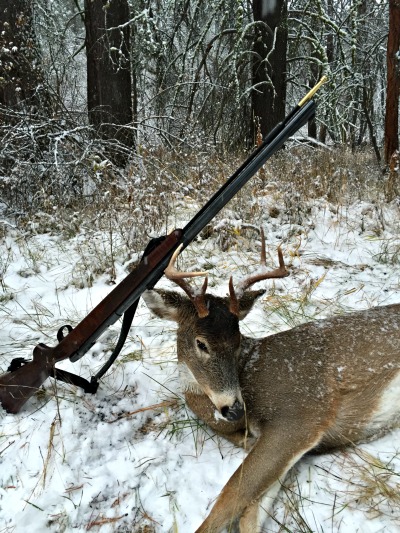Whitetails and Black Powder
By Gary Lewis

Hunt late season deer with a muzzleloader in northeast Oregon.

"The first time he woke up he had a pretty nice little 8-pointer standing twenty feet away from him," Carl Shaver said. Before the sleepy hunter could clear the cobwebs from his head, the buck got spooky and whirled around.
For his first foray after whitetail deer in northeast Oregon, Shaver had recruited his brothers-in-law, David Harris and Hank Schaffeld, to apply with him. They all drew tags on their first try.
They decided to spend most of the time calling and rattling. Schaffeld won the coin toss. He was up first.
Both Schaffeld and Harris carried Oregon-legal CVA in-lines. Shaver hunted with his Austin & Halleck bolt-action muzzleloader.
"We sat there and called and called," Shaver said. "And sitting there in the sun, Schaffeld went back to sleep. It wasn't too long after that a deer stepped on a branch and milled around then stopped, broadside at 20 yards."
When he'd fallen asleep again, Schaffeld slipped down with just his shoulders against the log and now, wide awake, with a buck on alert, ready to bolt, he rested the butt of the gun against his bicep and squinched down to get the sights aligned.
BOOM. The buck dropped in its tracks.
After Schaffeld's buck was hanging on the meat pole, it was Harris' turn. He was hoping to tie his tag on a doe. After several deer had shown themselves, a deer came in to see what the commotion was all about, and when the smoke cleared, Harris had his first muzzleloader whitetail on the ground.
The trio tried rattling and grunting, but when they were able to observe deer and call to them, neither the bucks or the does would respond. "I think it was the stage of the rut we were in," Shaver said, "but they wouldn't come to rattling."
"What they wanted to hear was the doe bleat," Shaver said. He used a Primos Doe Bleat can, operated by turning the unit over and over again, which activates the call that sounds like a whitetail doe in estrus. The sound can bring in both bucks and curious does.
Shaver, Harris and Schaffeld spent two hours in each call set, calling with two bleats every five minutes.
"It wasn't a rush deal," Shaver said. "We called in quite a few." Bucks came the fastest.
"We had a few that caught us flat-footed." Once, a spike came to the call and then stayed around to rub out his antlers on the tree behind where Schaffeld sat.
Most shot opportunities presented at under 100 yards, but Shaver said, for next season he plans to practice at 100 yards just in case a good buck holds up a long way out.
The first part of the hunt produced good action, but when the snow hit, the deer really began to move.
"Then it turned cold. It was 10-below-zero and the temperature shut them off," Shaver said.
By that time, Carl Shaver had his own buck in the salt, an 8-pointer by the eastern way of counting. That one also came to the doe bleat.
"I had done my homework, talked to some people on two scouting trips and knew where to find the deer. By far we saw more whitetail than mule deer," Shaver said.
Three Late Season Options
The Department of Fish and Wildlife offers three late-season whitetail muzzleloader hunts in NE Oregon. The Baker Muzzleloader hunt (151M) takes in all of the Sumpter, Pine Creek, Keating and Lookout Mountain units with about 45 percent public land. In 2015, it took one or two preference points to draw this one with certainty.
The Union County hunt (153M) takes place during the second half of November and is easier to draw, but the whitetails are concentrated on and around private lands.
Hunters in the N. Wenaha-E. Sled Springs (156M) season take to the field in the first part of December. Easy to draw, this hunt also takes place on and around private lands. It's a good idea to pre-scout and talk to landowners before applying for the tag.
Oregon's whitetail-only muzzleloader deer hunts are an interesting option for the hunter that would carry a single-shot, 1840s-technology gun. The bag limit is one white-tailed deer of either sex.
A hunter should be prepared to pass up mule deer waiting for a crack at a whitetail, and plan in advance to know the difference. And stay awake. Don't get too comfortable.


